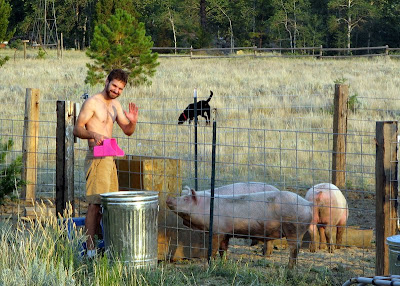It took me exactly one week to stop feeling so terrible that I could write about the results. No question, Blondie was bad, but so was I. I had cooked the chicks.
I did bring myself to check the eggs and calculate fertility rates. Blondie started with 11 eggs. Of these, only four (36%) had developed almost fully. The two eggs I left under Mama Blondie turned out to be unfertilized.
From beginning (acquiring the rooster and introducing him to the flock), to end, this hopeful-turned-horrible project took about 7 weeks.
Just to be clear, I am not giving up. And, true to my streak of impatience, I went straight away to Murdoch's ranching store and, against Bill's better judgement, bought the solo egg incubator they had on the shelf. I was determined to hatch some baby chicks even if Blondie wouldn't cooperate.
The incubator I brought home is made by Little Giant, model 9200, which is a still air (no circulation) variety. I added some accessories: an automatic egg turner and a fan, to increase probability of survival. (Eggs need to be turned 2 to 3 times a day to prevent the yolk from sticking to the shell and screwing up chick development. Also, a fan keeps the temp more uniform.) When I pulled the contraption out of the box, I was staring at, basically, nothing more complicated than a Styrofoam container, two pieces fitted together, with two plastic windows on top to watch the incubation progress, and a place for eggs and a heating element inside. Very efficient, but nothing fancy.
I knew energy would be an issue, but the heating element itself runs about equivalent to a 40 watt bulb. This is do-able when we have decent sun days, like we're having now. So I was ready to dive in again and gather up some more eggs. Bill semi-grudgingly let me scheme and dream along, all the while gently reminding me the energy requirement for this endeavor might be too high. It wasn't until he pointed out that beyond the 21 days of incubation, we'd require probably another 6 weeks of a heating element for the growing baby chicks. That would put us running an inefficient heating lamp into November and December...months when we just don't have that kind of solar energy.
I finally came back to reality, abandoned my immediate plan to start again, and temporarily packed up the incubator. It can wait a few more months to hatch some chicks. And so can I.
Lessons Learned:
- It is extremely hard to try and simulate the conditions underneath a broody hen (I failed miserably). She keeps it 99.5 degrees and 80% humidity. She also turns the eggs several times daily, until the last week of their development, when they do best to stay in the same position to prep for hatching.
- Not all hens make good mothers.
- "Time and tide [and sun] wait for no man". But sometimes you do have to wait for it.








